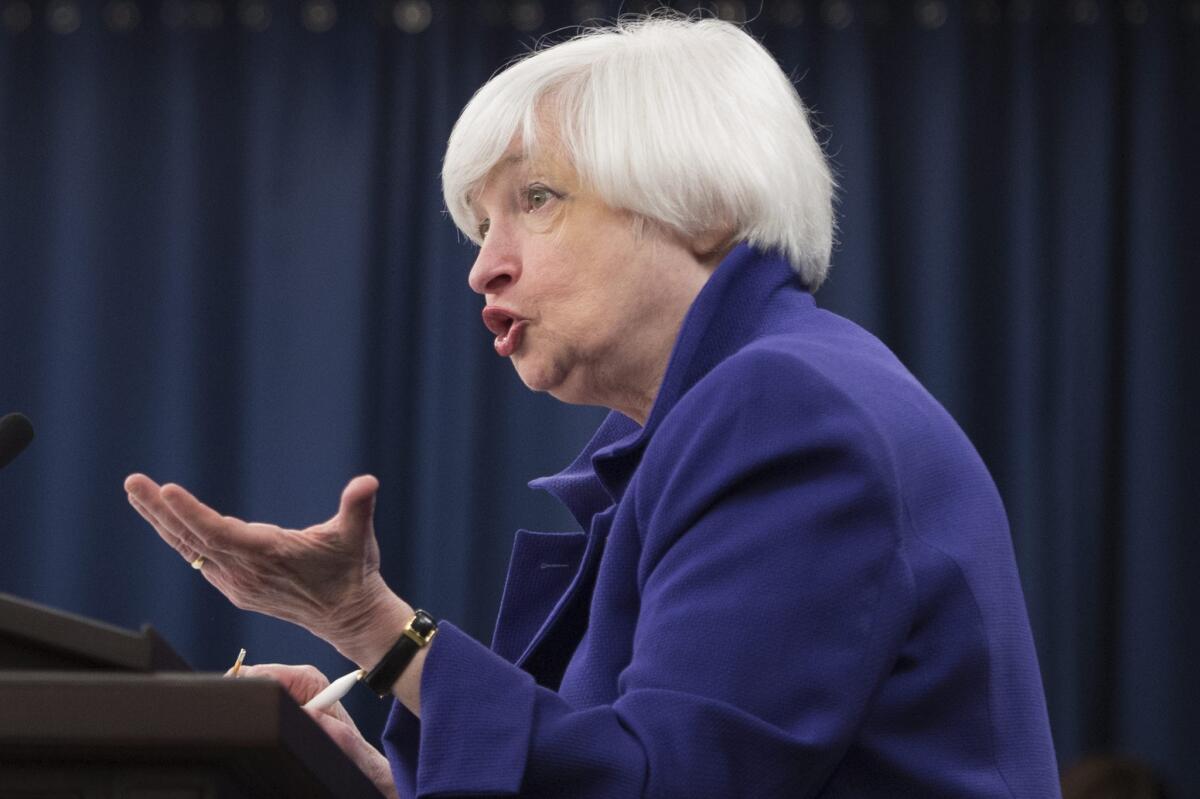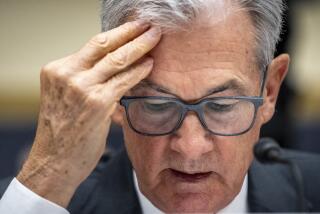Why the Fed’s historic rate hike is good news and bad news for the economy

Federal Reserve Chairwoman Janet L. Yellen speaks with reporters Wednesday after the central bank announced the first increase in a key interest rate since 2006.
- Share via
Reporting from Washington — In late 2008, with the unemployment rate soaring and a crippled financial system propped up by government bailouts, the Federal Reserve pushed its key short-term interest rate as close to zero as possible.
Now, exactly seven years after that unprecedented decision, central bank policymakers unanimously declared the economy strong enough to finally start inching the rate up again.
“The economic recovery has clearly come a long way, although it is not yet complete,” Fed Chairwoman Janet L. Yellen declared Wednesday.
But the much anticipated hike was both good and bad news for the U.S. economy.
It validated the strength of the slow-moving recovery from the Great Recession, which investors cheered. The Dow Jones industrial average rallied after the announcement, closing up about 224 points.
“It was a vote of confidence” in the economy, said Kathy Bostjancic of Oxford Economics in New York.
But the move also points to the inevitable — and some say long overdue — next economic downturn.
Join the conversation on Facebook >>
“It’s a healthy sign that the economy, in the Fed’s judgment, can withstand modest rises in interest rates,” said Russell Goldsmith, chief executive of City National Bank in Los Angeles. “But it also tells you the Fed needs to have gas in the gas tank so if the economy slows down, they can put more fuel in the economy.”
“When your interest rate is zero,” he said, “you can’t lower it.”
So Fed policymakers took the first cautious step to nudge up by 0.25 percentage point their benchmark federal funds rate, which affects terms for many consumer and business loans. They promised future increases would come only gradually.
The practical effect for consumers will be minimal, at least in the short term, experts said.
Even Yellen sought to downplay any immediate impact.
“I think it’s important not to over-blow the significance of this first move,” she said. “Remember, we have very low rates and we have made a very small move.”
Auto loans and credit card interest rates probably will tick up soon. Mortgage rates are less directly affected and already have risen in anticipation of the Fed’s action.
And savers are unlikely to see returns on bank accounts and CDs increase by much if at all until at least another one or two rate hikes, expected next year.
“Don’t expect to walk by your local bank branch and see savings rates go up on Thursday,” said Patrick Schaffer, a global investment specialist with J.P. Morgan Private Bank in L.A. “It will take a little bit of time to flow through to where people will actually feel it.”
On Wednesday, several major banks, such as Wells Fargo, Bank of America, JPMorgan Chase and Citibank, announced a 0.25-percentage-point increase in their prime rates, which is used to set terms for credit cards, auto loans and home equity lines of credit. But the banks did not increase the interest they pay depositors on savings and CDs.
NEWSLETTER: Get the day’s top headlines from Times Editor Davan Maharaj >>
For small businesses, which have been slower to recover from the Great Recession, the Fed’s move was welcomed as a necessary first step toward a more normal economy, said William Dunkelberg, chief economist for the National Federation of Independent Business, a lobbying group for small employers.
As a practical matter, he said, “a quarter point does nothing really” for small firms.
“Everybody’s already got their low-interest loans,” he said.
Sales remain sluggish and the organization’s latest survey shows more small business owners expect the economy to be weaker six months from now than stronger.
“It’s just plodding ahead,” Dunkelberg said of the economy, “and you don’t borrow money, even if it’s cheap, and invest it in plodding.”
The major significance of the long-awaited rate increase could be more psychological. Yellen described the hike as a major turning point in the nation’s efforts to put the Great Recession behind it.
“This action marks the end of an extraordinary seven-year period during which the federal funds rate was held near zero to support the recovery of the economy from the worst financial crisis and recession since the Great Depression,” Yellen said. “It also recognizes the considerable progress that has been made toward restoring jobs, raising incomes and easing the economic hardship of millions of Americans.”
As the economy continues to strengthen, Yellen emphasized that Fed policymakers would move slowly with future rate hikes to avoid stifling economic growth.
A majority of the 17-member Fed’s policymaking committee expect the rate to rise to at least 1.375% by the end of 2016, according to projections released Wednesday. That would still be low by historical standards.
The rate was 5.25% in 2006 when the Fed began lowering it in response to the economic slowdown that led to the Great Recession.
Policymakers had good reason for lifting the rate from its near-zero level.
With the jobless rate down to 5% — and close to an optimal level before it starts to stir up inflation — many economists anticipated a rate hike much earlier this year.
But the Fed decided not to raise the rate in September, because of the turmoil in global markets, triggered largely by uncertainties about China’s growth.
Three months later, some thought Yellen should have waited a bit longer to tighten monetary policy.
The world economy remains sluggish, with emerging markets foundering. In addition, the recent dive in oil prices has pushed down inflation and intensified a sell-off in high-yield, junk bonds, threatening some market funds and raising concerns about a spillover to the broader financial system.
“It seems like it was fueled by the Fed’s need to fulfill the promise it made to the market to raise rates by the end of the year and by hopeful unfounded expectations of further growth down the road,” Lindsey M. Piegza, chief economist at brokerage firm Stifel Nicolaus & Co., said of Wednesday’s increase.
“I think any future rate increases will have to be very gradual and very minimal or the Fed will tighten the U.S. economy into a recession,” she said.
Yellen acknowledged concerns about the global economy. But she said conditions in the U.S. warranted a rate hike.
Although part of the reason for an increase was to give the Fed greater ability to respond to “negative shocks,” Yellen said she didn’t think a recession was looming.
“The underlying health of the U.S. economy I consider to be quite sound,” she said. “I think it’s a myth that
expansions die of old age … so the fact that this has
been quite a long one doesn’t lead me to believe that it’s one whose days are numbered.”
Follow @JimPuzzanghera on Twitter
MORE FROM BUSINESS
Stock indexes rise after Fed raises interest rates
Southern California home sales edge up in November
EPA report shows backsliding on auto fuel economy and emissions, critics say
More to Read
Inside the business of entertainment
The Wide Shot brings you news, analysis and insights on everything from streaming wars to production — and what it all means for the future.
You may occasionally receive promotional content from the Los Angeles Times.












